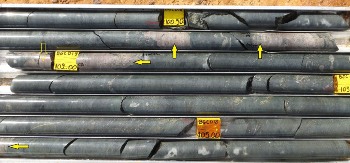Alphamin Resources Corp. (“Alphamin” or the “Company”) is pleased to announce that the resource drilling programme at the Gecomines target on its wholly owned Bisie Tin Prospect (Bisie Project) in east central Democratic Republic of Congo (DRC) is progressing with 1,444m of the planned 3,695m drilled to date.
 Figure 1: Massive cassiterite veins in NQ drill core from drill hole BGC018 (yellow arrows indicate pinkish brown cassiterite veins)
Figure 1: Massive cassiterite veins in NQ drill core from drill hole BGC018 (yellow arrows indicate pinkish brown cassiterite veins)
The strongest visible tin mineralization to date was intersected in drill hole BGC018 shown in Figure 1. Several veins of approximately 100 – 600mm thickness with an accumulated thickness of roughly 2m where intersected. This highly significant intersection suggests zones of high grade mineralization can be expected throughout the Gecomines target area.
Initial drillholes BGC011, 12, 13, 14, 15 and 16 from the current programme (collar locations shown in Figure 2) focused on the area worked extensively by artisanal miners. In the past massive cassiterite veins were mined from outcrop down to approximately 50m below surface.
In house Niton XRF analyses conducted on pressed pellets derived from the drill core, indicate that significant fine grained tin mineralization in the wall rock adjacent to mined out veins intersected in the drilling can be expected.
Significant copper mineralization was also intersected with native copper reported over 1.65m in BGC012 shown in Figure 2.
Visual mineralisation for holes completed to date is shown in Table 1. Sample submission was delayed because the Company experienced delays in acquiring export permits necessary for sample submission. Samples from 7 drill holes have now been received by the ALS Chemex laboratory in Johannesburg with first results expected by end of the quarter.
Additional drilling at Bisie has firmed up a robust geological model which is guiding the current resource drilling programme and future exploration. Tin mineralization is focused within a chloritic, garnetiferous amphibolite unit within felsic mica schists. Occasionally cassiterite bands are developed in the footwall schists in close proximity to the amphibolites. The amphibolite unit is consistently 20-25m thick although in some drill holes the unit and corresponding tin mineralization might be less due to faulting or quartz veining.
The Company remains confident of identifying a significant high grade tin resource down to depths of below 200m below surface at the Gecomines target area with continued drilling.
Tin Deportment Study
Sixty four kilograms of quartered drill core were sent to SGS Laboratories in Johannesburg for a metallurgical deportment study. This study will test the suitability of the ore to dense media separation as well as the effects of finer grinding on recovery rates at differing grind sizes. The base metal sulphide minerals will also be traced during the study and Qemscan bulk mineral analysis will quantify the major mineral components of the sample. Results of the study will aid the design of future metallurgical testing programmes that will be done on a larger scale and focus on both tin and base metal recovery, with the ultimate aim of facilitating the final process plant design. Results for the deportment study are expected within two months.
Security
Despite recent tensions in Goma operations have continued unhindered while the Company continues to receive strong local and Government support.
Project Back Ground
The Bisie project is located in the Walikale district of North Kivu Province DRC and is held by Alphamin’s 100% owned Mining and Processing Congo sprl (MPC) which holds a total of five tenements covering an area of 1,470sqkm with significant tin, gold and base metal potential. The key prospects within the Bisie Project are the Bisie Tin Prospect mined previously by artisanal means and the Omate gold workings exploited historically by the Belgians and currently mined extensively by artisanals.
The Bisie Prospect was the DRC’s largest producer of tin ore for a number of years and accounted for up to 75% of the DRC’s tin output.
Alphamin lifted force majeure on PR5266 which hosts the Bisie Prospect in February 2012 and commenced diamond drilling during the second half of 2012 at two target areas, Gecomines and Golghota, mined extensively from surface by artisanal miners. Significant high grade tin mineralisation was reported from drilling at both target areas down to depths exceeding 150m. The tin mineralisation is also closely associated with copper and light rare earth (cerium and lanthanum) mineralisation as well massive and disseminated lead and zinc sulphides and significant amounts of silver. Geochemical soil sampling has highlighted anomalous lead and zinc in soils for a further 2km to the south of the Golghota workings. Drilling has confirmed the association of copper, lead, zinc and tin mineralisation at depth below the soil anomaly in holes drilled to the south of the Golghota workings.
The lead and zinc in soil anomaly has been defined over a minimum of 4km along the Bisie ridge and remains open to the south where the soil sampling has not been completed. High grade mineralisation at Bisie appears to be controlled by a series of crosscutting northeast or east-west trending faults identified along the ridge from Landsat imagery. The Company is therefore highly confident of discovering new high grade zones of tin and base metal mineralisation from systematic exploration along the ridge.
Amendment to Release of March 25, 2013
Further to March 25, 2013 news release with the appointment of Mr Tom Borman to the Alphamin Board of Directors, Mr Borman was referred to as a Chartered Accountant. The Company wishes to amend this statement as Mr Borman resigned from the position of Chartered Accountant on 6th October 2009.